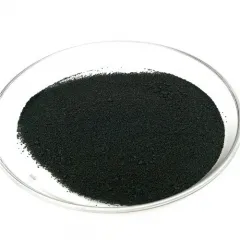- Home
- Products
- Elementary
- Boride Powder
- 3D Printing Powder
- Sulfide Powder
- Oxide Powder
- Carbide powder
- Nitride Powder
- Silicide Powder
- Hydride Powder
- Telluride Powder
- Selenide Powder
- Stearic Acid Series
- Phosphide Powder
- Nanoparticles
- Metal Alloy
- MAX Phase
- Lithium Battery Anode
- Surfactant
- Molecular sieves
- Concrete Admixtures
- Cladding of metals
- News
- Blog
- Contact
- About
Preparation of Copper Sulfide Nanoparticles and Its Application in Transparent Heat Iinsulation Coatings
Preparation method of copper sulfide nanoparticles:
Chemical precipitation method
The method is simple in operation, low in cost, and can realize large-scale production. In the chemical precipitation method, the copper salt and sulfide salt solution are usually mixed to adjust the pH value so that copper and sulfur ions react to generate copper sulfide precipitation. Then, the final copper sulfide nanoparticles are obtained through the post-treatment steps of washing, drying, and heating.
To obtain copper sulfide nanoparticles with uniform morphology and size, it is necessary to control the reaction conditions precisely, such as temperature, pH value, reactant concentration, etc. In addition, surfactants can be introduced in the reaction process or surface modification of the product to improve the performance of copper sulfide nanoparticles.
Microemulsion method
The microemulsion method is an effective method for preparing nano-scale materials. In the microemulsion method, water-in-oil or oil-in-water microemulsion is formed by mixing two insoluble solvents. By adding copper salt and sulfide salt to the microemulsion, copper and sulfur ions react in the microemulsion to produce copper sulfide nanoparticles by controlling the reaction conditions.
The particle size of copper sulfide nanoparticles prepared by the microemulsion method is small, and the particle size distribution is narrow. However, the preparation process of the microemulsion method is complicated and expensive, which is unsuitable for large-scale production.
Vapour deposition method
Vapour deposition is a method for preparing inorganic nanomaterials. In vapour deposition, the raw material gas is converted into active molecules or atoms by heating or chemical reactions, and then physical or chemical reactions occur on the substrate to form a solid film or nanoparticle.
In preparing copper sulfide nanoparticles by vapour deposition, the copper source and sulfur source gas are usually passed into the reaction chamber, and the biochemical reaction is carried out under certain conditions to produce copper sulfide nanoparticles. The copper sulfide nanoparticles prepared by vapour deposition have high purity and good crystallinity, but the equipment cost is high, and the operation conditions are strict.

Application of copper sulfide nanoparticles in transparent heat insulation coatings:
Characteristics of copper sulfide nanoparticles
Copper sulfide nanoparticles have excellent physical and chemical properties, such as high stability, electrical conductivity, and optical properties. In the visible light range, copper sulfide nanoparticles have high transmittance, can effectively block the heat of sunlight, and have good thermal insulation performance. In addition, the size of copper sulfide nanoparticles can be adjusted, the morphology can be controlled, and the properties of copper sulfide nanoparticles can be further optimized by surface modification.
The application of copper sulfide nanoparticles in transparent heat insulation coatings
Direct dispersion method
The copper sulfide nanoparticles are directly dispersed in the base material of the transparent coating, and the nanoparticles are evenly dispersed in the base material by stirring and ultrasonic methods. Then, the transparent heat insulation coating is prepared through the conventional coating process, such as grinding, coating, etc. This method is simple to operate, low in cost, and suitable for large-scale production.
Sol-gel method
The copper sulfide nanoparticles were combined with the components of the transparent coating by sol-gel method. The copper sulfide nanoparticles were dispersed in an organic solvent, added with gels and crosslinkers, and formed transparent and uniform sol through hydrolysis and polycondensation. Then, the sol is coated on the substrate, and the transparent heat insulation coating is prepared by drying and heat treatment. The coating prepared by this method is uniform and transparent, but the process is complicated.
Composite coating method
Copper sulfide nanoparticles were combined with another material with excellent thermal insulation properties to prepare a composite coating. For example, copper sulfide nanoparticles are combined with transparent silicate glass to prepare a composite coating with excellent thermal insulation and weather resistance. The coating prepared by this method has excellent performance, but the process is complicated and expensive.
Advantages and challenges of copper sulfide nanoparticles in transparent thermal insulation coatings
Copper sulfide nanoparticles have the following advantages in transparent heat insulation coatings: high light transmittance, high heat insulation performance, adjustable particle size, controllable morphology, etc. At the same time, copper sulfide nanoparticles have good chemical stability and environmental friendliness and are harmless to the environment and the human body. However, the application of copper sulfide nanoparticles in transparent thermal insulation coatings still faces some challenges:
How to achieve large-scale production and reduce costs.
How to improve the wearability and long-term stability of the coating.
How to solve the accumulation and dispersion of nanoparticles.

Supplier of copper sulfide nanoparticles:
Synthetic Chemical Technology Co. Ltd. is an established global chemical material manufacturer and supplier with over 12 years of experience producing high-quality nanomaterials. These include copper sulfide, nitride particles, graphite particles, sulfide particles, 3D-printing powders, etc.
We are happy to answer any questions you may have. ( sales5@nanotrun.com)
Inquiry us